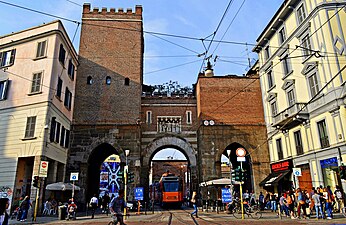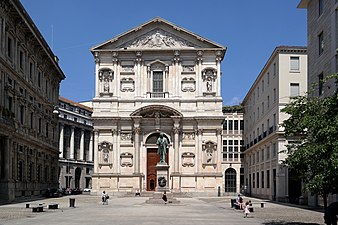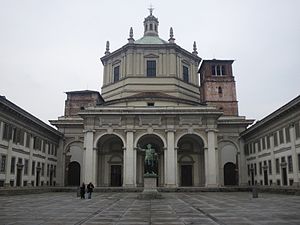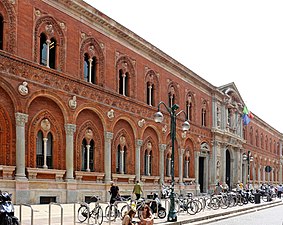Zone 1 of Milan
Zone 1 of Milan
Municipality 1 | |
|---|---|
UTC+2 (CEST ) |
The Zone 1 of Milan, since 2016 officially Municipality 1 of Milan, (in Italian: Zona 1 di Milano, Municipio 1 di Milano) is one of the 9
It was officially created as an administrative subdivision during the 1980s. On 14 April 2016, to promote a reform on the municipal administrative decentralization, the City Council of Milan established the new Municipality 1, a new administrative body responsible for running most local services, such as schools, social services, waste collection, roads, parks, libraries and local commerce.[2]
The zone includes the historical center of the city. It is the least populated of the city's zones and one of the smallest by area, a significant part of which is occupied by
Subdivision
The zone includes the following districts:
- fortune tellers' booths.
- LBGT venues in Milan, such as the "Lelephant" and the "Atomic Bar".[8]
- Sarpi, which includes a large portion of the Milanese Chinatown, home of the oldest and largest Chinese community in Italy. Originally established during the 1920s by immigrants who used to operate small textile and leather workshops, today the district is filled with hairdressing salons, fashion boutiques, silk and leather stores, libraries, traveling agencies, medicine centres and massage parlours. The Chinese takeaways and restaurants in the area are mostly specialised in Zhejiang cuisine. Several Italian-Chinese companies are also headquartered in the neighborhood, including the editorial desk of the newspaper Europe China Daily. Via Paolo Sarpi is the main street and is largely a pedestrian area.
- Porta Tenaglia;
- Ticinese;
- Duomo;
- Magenta-San Vittore;
- Quadronno;
- Pagano;
Sestieri
As many cities in Italy, the historic centre of Milan is also subdivided into many historical sestieri, medieval subdivisions themselves subdivided into different contrade.
| Sestiere | Coat of arms | Contrade |  Nobles Contrade: Contrada capitana: | |
| 1 | Porta Orientale | 
|
1. Contrada del Verzaro 2. Nobile Contrada delle Farine 3. Contrada dell'Agnello (Lamb) 4. Contrada della Cerva (Doe) 5. Contrada di Bagutta | |
| 2 | Porta Romana | 
|
6. Contrada del Falcone (Falcon) 7. Nobile Contrada della Cicogna (Stork) 8. Contrada del Fieno (Hay) 9. Contrada del Brolo 10. Contrada delle Capre (Goats) | |
| 3 | Porta Ticinese | 
|
11. Contrada della Lupa (She-wolf) 12. Nobile Contrada di Sant'Ambrogio 13. Contrada delle Cornacchie (Crows) 14. Contrada del Torchio 15. Contrada della Vetra | |
| 4 | Porta Vercellina | 
|
16. Contrada della Piscina 17. Nobile Contrada della Rosa (Rose) 18. Contrada dei Morigi 19. Contrada della Porta 20. Contrada del Nirone | |
| 5 | Porta Comasina | 
|
21. Nobile Contrada del Cordusio 22. Contrada del Rovello 23. Contrada dell'Orso (Bear) 24. Contrada del Campo (Field) 25. Contrada dei Fiori (Flowers) | |
| 6 | Porta Nuova | 
|
26. Contrada dell'Aquila (Eagle) 27. Nobile Contrada dei Bossi 28. Contrada della Mazza 29. Contrada degli Andegari 30. Contrada della Spiga (Ear) | |
Fashion district

The sides of the square, located to the south of the arches of
.Streets inside this area include
Government

The area has its own local authority called Consiglio di Municipio (Municipal Council), composed by a president and 30 members directly elected by citizens every five years. The council is responsible for most local services, such as schools, social services, waste collection, roads, parks, libraries and local commerce in the area,[2] and manages funds (if any) provided by the city government for specific purposes, such as those intended to guarantee the right to education for poorer families.
The current president is Mattia Abdu (PD). He was elected in the 2021 Milan municipal election together with the 30-member Municipal Council, whose composition is shown below:
| Alliance or political party |
Members | Composition | ||
|---|---|---|---|---|
| 2021–2026 | ||||
| Centre-left (PD-EV) |
21 | 21 / 30
|

| |
| Centre-right (FI-L-FdI) |
9 | 9 / 30
| ||
Here is a full lists of the directly elected Presidents of Municipio since 2011:
| President | Term of office | Party | ||
|---|---|---|---|---|
| Fabio Luigi Arrigoni | 16 May 2011 | 8 October 2021 | PD | |
| Mattia Abdu | 8 October 2021 | Incumbent | PD | |
Gates
In the past the city Milan had three different systems of defending walls. The oldest one,
Main gates which still today mark the entrance to Zone 1 are:
- Napoleonic rule, the Arch of Peace was built by architect Luigi Cagnola. This new gate marked the place where the new Strada del Sempione entered Milan. This road, which is still in use today, connects Milan to Paris through the Simplon Pass crossing the Alps.
- Porta Venezia, originally known as Porta Orientale ("Eastern Gate"). Already part of the Roman walls, it was renewed in neoclassic style during the first half of the 19th century.
- Porta Ticinese.
- Porta Nuova.
- Porta Romana.
-
Arch of Peace in Porta Sempione
-
Porta Venezia
-
Porta Ticinese
-
Porta Nuova
Squares
The zone is characterized by the presence of many squares (Italian: piazze), among which the most famous are:
- Piazza del Duomo, which marks the exact center of the city and includes some of the most important buildings of Milan, as well some of the most prestigious commercial activities, and it is by far the foremost tourist attraction of the city.
- Teatro alla Scala opera house, which occupies the north-western side of the square.
- Piazza San Babila, created during the 1930s.
- San Fedele Church.
- Piazza Cordusio, well known for its several neoclassical, eclectic and Art Nouveau buildings, banks and post offices.
- Italian Bourse.
-
Piazza Cordusio
-
Piazza Meda with Arnaldo Pomodoro's Grande Disco (1972)
-
Monument to Alessandro Manzoni in Piazza San Fedele
-
Monument to Emperor Constantine in front of San Lorenzo Basilica
-
Monument to Leonardo in Piazza della Scala
-
Monument to Cesare Beccaria in Piazza Beccaria
-
Monument to Francesco Hayez in Piazza Brera
Education
Thanks to its central position, the zone houses some prominent educational institutions. In this area are located the main buildings of many higher education institutions:
- University of Milan, founded in 1924, is located not so far from the Piazza del Duomo. At the end of the Second World War, the old Ospedale dei Poveri (Hospital for the Poor) building, known as "la Cà Granda" (the Big House), was assigned to the University. The building, one of the first Italian examples of civil architecture – commissioned in the 15th century by the Sforza family, the dukes of Milan – was seriously damaged by the bombings of 1943. In 1958, after a complex series of reconstruction and renovation works, it became home to the University Rector's Office, the administrative offices and the schools of Law and Humanities.
- Jesuitcollege.
- Conservatory of Milan, college music established in 1807 by royal decree. Today it is the largest institute of musical education in Italy.[9]
-
University of Milan headquarter
-
Brera Academy
-
Brera Academy internal courtyard
-
Conservatory main entrance
Museums
The zone houses all the most important museums of the city. The main are:
- Royal Palace, cultural center which homes many international temporary exhibitions.
- Triennale, a design and art museum in which homes the Milan Triennial of art and design exhibition.
- Pinacoteca di Brera, the main public gallery for paintings in Milan.
- Ildefonso Schuster in 1931 as a vehicle to protect and promote the art collection of the Archdiocese of Milan.
- Museo del Novecento, opened in 2010. Seated in Palazzo dell'Arengario near Piazza del Duomo, it's one of the most important museums of modern art in Italy.
- collections of Fondazione Cariplo with a strong representation of the 19th century Lombard painters and sculptors, including Antonio Canova and Umberto Boccioni. A new section was opened in the Palazzo della Banca Commerciale Italianaon 25 October 2012 with 189 art works from the 20th century.
- Giuseppe de Cristoforisdonated his collections to the city.
- Museo Nazionale Scienza e Tecnologia Leonardo da Vinci, founded in 1953, is the largest science and technology museum in Italy and is dedicated to Italian painter and scientist Leonardo da Vinci.
- Galleria d'Arte Moderna.
-
Royal Palace
-
Triennale
-
Natural History Museum
-
Museo del Novecento
Transport

Stations of Milan Metro in Zone 1:
 Cadorna, Cairoli, Cordusio, Duomo, Palestro, Porta Venezia, San Babila;
Cadorna, Cairoli, Cordusio, Duomo, Palestro, Porta Venezia, San Babila; Cadorna, Lanza, Moscova, Sant’Ambrogio;
Cadorna, Lanza, Moscova, Sant’Ambrogio; Crocetta, Duomo, Missori, Montenapoleone, Porta Romana, Turati.
Crocetta, Duomo, Missori, Montenapoleone, Porta Romana, Turati. San Babila, Tricolore.
San Babila, Tricolore.
Future stations of Milan Metro will include:
Zone 1 is also interested by
Due to this traffic restrictions, the Zone is predominantly characterized by many pedestrian zones and easily accessible by bike.
Other notable places

- Duomo;
- La Scala opera house;
- Galleria del Corso;
- Galleria Vittorio Emanuele II, the world's oldest shopping mall;
- Palazzo Marino, Milan's city hall;
- Piccolo Teatro;
- Basilica di Sant'Eustorgio;
- Sempione Park;
- Indro Montanelli Public Gardens;
- Torre Velasca.
Maps
-
Map of Zona 1
-
Area C traffic restricted zone (ZTL)
References
- ^ (in Italian) The 9 city councils of Milan (municipal website)
- ^ a b Municipality of Milan – Municipalities
- ^ Fiori Chiari Archived 1 January 2011 at the Wayback Machine (one of the best known streets in Brera)
- ^ Il camper del Corriere al Sempione
- ^ Milan Guide: Porta Venezia Archived 8 March 2013 at the Wayback Machine (in Italian)
- ^ a b Movida a Porta Venezia (in Italian)
- ^ a b Le mille e una notte vivono a Porta Venezia (in Italian)
- ^ Verso un nuovo quartiere gay Archived 15 November 2010 at the Wayback Machine
- ^ "Official website" (in Italian). Conservatorio "Giuseppe Verdi" di Milano. Retrieved 13 January 2016. (In the Conservatorio drop down menu)
- ^ "Area C è partita: calate del 40% le auto in centro dopo l'entrata in vigore del pedaggio" [Area C takes off: auto traffic decreased 40% in the center after the toll goes into force]. Corriere della Sera Milano (in Italian). 16 January 2012. Retrieved 16 January 2012.
- ^ Martino, Angelo. "Milano: from pollution charge to congestion charge" (PDF). Retrieved 17 January 2012.
- ^ "Area C. Istituita la congestion charge definitiva". Comune di Milano. Retrieved 13 May 2013.
External links
![]() Media related to Municipio 1 (Milan) at Wikimedia Commons
Media related to Municipio 1 (Milan) at Wikimedia Commons
- (in Italian) Zone 1 of Milan (municipal website)





















